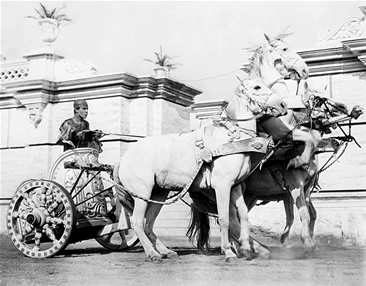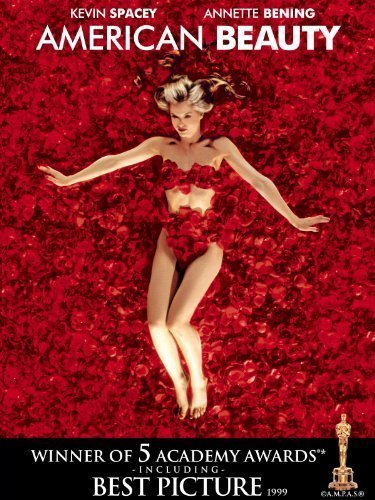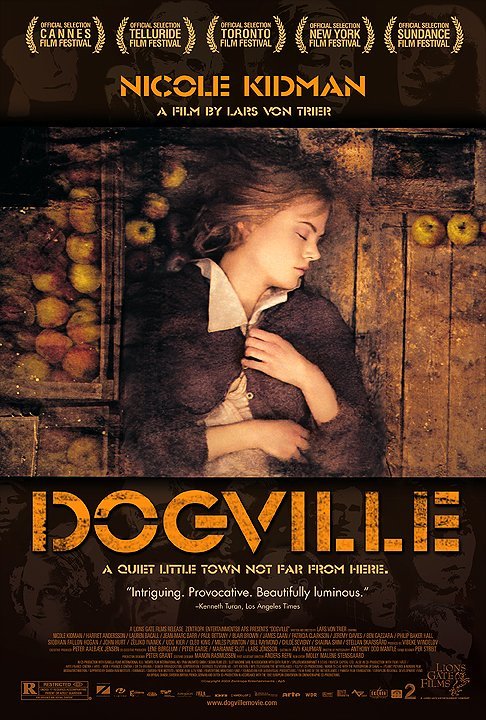| HOME | PRESENTACIÓN | ¿FILMAR LA HISTORIA? | DIRECCIÓN-REDACCIÓN | NÚMEROS PUBLICADOS | NORMAS DE PUBLICACIÓN | CONTACTOS | ENLACES |
 |
REPRESENTATIONS OF THE HERO AND Representaciones del héroe y de los estereotipos americanos Dr. Ana Bela Morais
Recibido el 13 de Septiembre de 2012 Abstract. Through a cultural reasoning about films like American Beauty (Sam Mendes, 1999), Dogville (Lars Von Trier, 2002) and History of Violence (David Cronenberg, 2005) we intend to study the way how the hero and the American stereotypes associated with the “American dream” are represented and critically thought.
On reflecting about the problems fought by the human being during the auto-reflexive construction of his personal identity, these films achieve the surpassing of personal identity to the problems faced by the collective one – specifically, in these films, the American cultural and social identity which arises as a metaphor of the globalized occidental world. In fact, Grace, the main character of Dogville, like John / Joe, the main character of History of Violence, can both being seen as metaphors of the way how America deals with other nations and its own history. Grace has always good intentions when she defends her ideals of natural goodness in all human beings. The problem arises when she understands that violence is inherent to human condition. When she perceives that her reaction is totally inspected: she destroys all the habitants of Dogville and becomes equal to those who she criticized – we cannot stop thinking about the way America intends to spread the “American way of life” to all countries and how this supposed good intention can interfere with other nations and different cultural representations. We intent to understand and explore these connections in these and others films (American Beauty, Sam Mendes, 1999; There will be blood, Paul Thomas Anderson, 2008) trying to find an answer to some questions like: How is the hero represented? How is personal identity characterized in its relationship with the collective ones? How is the “American way of life” perceived by other nations? At this point we can consider cinema as mediation to a better understanding of ourselves.
Resumen. A través de una reflexión cultural acerca de películas como American Beauty (Sam Mendes, 1999), Dogville (Lars Von Trier, 2002) e History of Violence (David Cronenberg, 2005) pretendemos estudiar el modo en el que son representados y pensados críticamente el héroe y los estereotipos americanos relacionados con el “sueño americano”.
Through a cultural reasoning about films like American Beauty (Sam Mendes, 1999), Dogville (Lars Von Trier, 2002) and History of Violence (David Cronenberg, 2005) we intend to study the way the hero and the stereotypes associated with the ‘American dream’ are represented and critiqued in film. By reflecting on the problems faced by the human being during the self’s construction of his or her personal identity, these films manage to look beyond individual identity to the problems posed by the definition of a collective identity — specifically, in these films, the American cultural and social identity which emerges as a metaphor of the globalized occidental world. Dogville, like American Beauty and A History of Violence, shows us an outwardly calm and peaceful society, which inwardly, however, shows it to be hypocritical and violent. American Beauty opens with an aerial view of a suburb in the north-eastern USA, the neatly ordered houses suggesting a social harmony that in fact is only illusory. The view is accompanied by a voiceover from the protagonist, Lester Burnham, who explains that he is already dead. This narration coming from the beyond recalls Sunset Boulevard (1950), and tells the life story of the late Lester, an advertising executive threatened with dismissal, married to Carolyn, a neurotic estate agent. Carolyn has her obsessions, the principal one, perhaps, being to cultivate roses — there are roses everywhere — and she has her delusions, one of them being that, as a modern mother, her daughter Jane is her best friend. And since she needs to believe in ‘American beauty’ she can’t bear the ‘low profile’ adopted by her husband, who unexpectedly starts to take himself for a failure, trailing behind his wife’s dreams of success. The family home feels as if it has been set up for a shoot for a home improvement magazine — even the roses are all the same size, whether they are in neatly arranged in vases, or growing in the garden. The sofas have that brand-new look, and Carolyn refuses to make love to Lester on them, so as not to spoil them. Family meals are accompanied by the sort of irritating background music to be found in a lift or a shopping centre. That is to say, American Beauty tells the story of a man and a woman who are married, and who apparently have everything that society could expect of them: she is pretty and independent, he is a successful professional man, they live in a dream house along with their adolescent daughter. One day, though, they realize the lack of sense and meaning in their lives. With the arrival of new neighbours, all the appearances they have cultivated start to fall apart. The normality of their suburban landscape is transformed into a cemetery of red roses, where the idyllic ‘American way of life’ lies buried.
At some point we may ask ourselves: where exactly is the American beauty here? On the contrary, we notice a lack of communication in the marriage, jobs that don’t match up to expectations, empty sexual lives. At a certain point Lester feels the need to cultivate sincerity, pleasure, leisure and physical exercise. In this respect, the film almost turns into a sort of ethnographic feature on the lines of the National Geographic magazine, but on the behaviour of Americans — or more precisely on the behaviour of the globalized middle classes. Although this film can be taken as a melodrama, it also functions as a black comedy on the falsity of the American dream. Built on the premise that happiness can only be created through material success, the dream turns out to be an illusory joy, and one that it is hard to live with. We may take the view that the director, Sam Mendes, has succeeded with American Beauty in challenging the stereotyped idyllic vision of the American middle class, or rather, the idea that we have created of the globalized western middle class. As Sam Mendes put it: “I was born in Great Britain and have never lived in the North American suburbs, but I don’t feel an outsider, rather a traveller, a sort of vagrant. I think I belong to the first generation of people who feel that the world is too small. My nationality doesn’t tie me down. Despite the similarities that exist between Great Britain and the US, this story is more global than American. It could be any western society.” (Mendes Cit. In Ponga 2000: 36). Like Dogville and A History of Violence, this film reflects on the diseased notions of harmony and solidarity embedded in the very idea of contemporary community, whether that community is the city, the neighbourhood, the street, or the family itself. In this respect, American Beauty could be read as a complete inversion of the America portrayed in Frank Capra’s It’s a Wonderful Life (1946), looking rather to the harsh and transgressive world of David Lynch’s Blue Velvet (1986), where we see contrasted purity and horror, eroticism and perversity. Like Blue Velvet, so too in Sam Mendes’ film the perfection of the roses in the well-tended gardens hides a dark and deep side, of unexpected alienation. This film, like Dogville, becomes almost a metaphor for the end of the ‘American empire’, along the lines of the Roman empire, which was brought down not by barbarian invasion, as was for so long imagined, but rather by crisis and corruption in its own society of the time. David Cronenberg’s film, A History of Violence, also reflects on the damaging effects of a globalized American society. The film opens with a long sequence which begins outside an old country hotel. A man emerges from the hotel and sits himself in the passenger seat of a convertible. This seems to constitute a nostalgic image, the first of many that run through this film, suggestive of one of many American myths. However, Leland and Billy, the first characters that we meet at the beginning of the film, are not any carefree adventurers — quite the opposite. The whole scene quickly turns sinister, especially when we hear the remark: ‘The maid was giving me trouble.’ Moments later, the scene breaks into a explosion of bloody violence, as banal and casual as the cigarette vending machines and the other consumer items which camera simultaneously pans over. This constitutes the epigraph to a film which, like the other two mentioned, becomes a fable about the human condition, and the apparent inevitability of violence. As with American Beauty, Dogville or Blue Velvet, A History of Violence leads us initially to accept its elegiac account of Millbrook and its inhabitants. One of the central focuses of the film is the vintage country house of the Stall family, situated amongst green pastures. Another of these focuses is the diner belonging to Tom, the main character in the film, which is just like any traditional diner in any American city, its calm 1940s atmosphere suggesting a quiet and honest existence — exactly the opposite of what is to happen throughout this film, and the other films referred to above. In the case of Tom, when he commits his first act of violence his wife Edie and his children start to ask themselves — in the same way as Fogarty, one of the Mafia men from Tom’s past — ‘How come he’s so good at killing people?’ For the audience who understand Tom as a symbol of America, this question could in turn suggest another: how is it that one of the greatest nations in human history has such a history of violence?
Dogville reflects on precisely this question. The film tells the story of Grace, a woman on the run, who arrives in a small mountain community called Dogville. To begin with the people in the village are all alien to her, then they become friendly, but gradually her new neighbours start to exploit her — having discovered that there is a reward for her capture they make Grace’s life hell. At the end of the film it is revealed that Grace’s father is a Mafia boss. He for his part leaves the fate of the village in her hands, telling her: ‘You shall treat these people the way they have treated you'. Dogville, the village imagined by Lars Von Trier, seems to be situated in the Rocky Mountains in the US, and time would be around 1930. However, the time and the place seem unimportant to us in the face of the complexity of the themes that the film asks us to consider. Dogville has many affinities with the theatre. The set is merely an empty studio, and the various film locations, such as private houses, shops etc., are simply sketched out with chalk on the dark floor. Each of the buildings contains some symbolic object that points to the 1930s, such as Tom’s desk, or some iron-frame bed or other. The atmosphere of suspense is created simply through the music, and by the play of light and shade. The opening scene of the film, by employing a high-angle shot, reveals the sort of décor associated with a board game or draughts. The tone of Dogville is thus established: the film may be thought of as a game. A game needs a player, and in this case it will be the young fugitive, Grace, willing to do anything to be accepted in the village. She offers herself up ‘like a gift’, as an ironic and elegant voice-off puts it, and she is quickly treated as a dog by the residents of Dogville. Sartre’s famous observation, that ‘hell is other people’ (Sartre 1947: 93), further demonstrates that, more than just ‘hell’, other people are an unavoidable precondition for us to know ourselves and to become ourselves. In his play, Huis clos, the three characters have died and find themselves in hell, that is to say, in a closed room where there are no mirrors, so that each depends on the others in order to recover his or her own identity. In Dogville, Grace is sexually abused by the men of the town, and the absence of a proper film set creates the feeling that all the characters, even those who are in their own homes and uninvolved in what is happening, are accomplices in these casual rapes. We can regard Dogville as an allegory on the corrupting effect of power. The village of Dogville can be read as a synecdoche, showing the way that America relates to foreign nations. At first the inhabitants seem to welcome the outside element, represented by Grace, but later they maltreat and exploit her as much as they can, having regard only to their own interests. We may recall here Theodor Adorno’s remark, that ‘anyone who isn’t after something is almost suspect: no one trusts anyone else to help them get by without legitimating themselves through counter-claims’ (Adorno 2001: 35). Lars Von Trier even establishes a parallel between what happens in the film and the debates on immigration. The director declares that “she [Grace] intrudes on them in their hometown, but at the same time she is vulnerable and has no other choice. I never thought the film would be a contribution to the immigration debate, but many parallels may be drawn. My parents were refugees in Sweden during the war. I think that the moral standing of a country can be measured by its attitude to refugees.” (Von Trier Cit. In Lumholdt 2003: 209). In fact, Grace, the main character in Dogville, and John / Joe, the main character in A History of Violence, can both be seen as metaphors of the way that America deals with other nations, and with its own history. Grace always has good intentions when she defends her ideals of natural goodness in all human beings. The problem arises when she concludes that violence is inherent to the human condition. When she perceives that, her reaction is totally unexpected: she destroys all the habitants ofDogville and becomes indistinguishable from those whom she had criticized — at this point we cannot avoid thinking about the way America intends to spread the ‘American way of life’ to all countries, and how this supposedly good intention can interfere with other nations and different cultural representations. On the other hand, in A History of Violence, John looks, at first glance, a perfect family man, with a good life and two lovely children, but one beautiful bright day his past comes knocking at his door and he is forced to face it. As in Paul Thomas Anderson’s Magnolia (1999) we can almost hear the words: ‘you can run away from the past, but the past is not through with you’. Another interesting point is that Dogville, A History of Violence and American Beauty are all directed by non-American directors. The way America is seen through the eyes of foreigners seems to be a good way of trying to reconstruct the mental image of America, and the way others perceive it. In these films we see how problems of identity faced by individuals can be interrelated with those faced collectively, by society as a whole.
In fact, despite possessing a universal relevance, American Beauty, Dogville and A History of Violence relate directly to American society. Sam Mendes, the director of American Beauty, is of British origin, and the fact of not being American seems to have helped him to achieve a critical distance from America, perhaps allowing him a clearer view of its reality. Indeed, it is interesting to note that many of the films that seem to us profoundly American were directed by foreigners, films such as John Schlesinger’s Midnight Cowboy (1969) or Roman Polanski’s Chinatown (1974) — and one could list many others. Sam Mendes surrounded himself with a crowd of Americans, thereby, in a way, bringing an American sensibility to the film. Remarking on the fact of Dancer in the Dark (2000) and Dogville being set in America, while himself being Danish, the director Lars Von Trier said: “I allow myself to be provoked. I was very provoked by lots of American journalists in Cannes. They were angry because I’d made a film about the USA although I hadn’t been there. So I thought: that’s fine… at last… now I’m going to make lots of American films. I also thought that it might be interesting for the Americans, and for others, to find out how someone who’s never been there sees America. If it were my country, Denmark, I would like to know what someone who hadn’t been there thought. Perhaps they think only of the Little Mermaid, or that the polar bears roam around there. How should I know? In any case it’s interesting to have one’s country illuminated. I didn’t think it was such a great sin. Besides, that is just what American filmmakers have always done.” (Von Trier Cit. In Lumholdt 2003: 208) In another interview the Danish director mentions that he made a point of having the voice of the narrator of Dogville recorded by an English actor, so as not to hide that the US was being described by an outside observer (Von Trier Cit. In Björkman 2003: 38). In light of what has been said above, we begin now to understand global capitalism as a process of constant negotiation between difference and homogenization, practised both globally and locally. Our affirming that capitalism is global does not mean that we are unaware that the process of globalization is driven by communication, not being restricted to capitalism. This process becomes especially evident in the physical and cultural changes in the geographies of cities. For this reason, according to Manuel Castells, the persistence of local difference is very often a function of globalization, one half of a dual process that involves, simultaneously, “the globalization of power flows and the tribalization of local communities.” (Castells Cit. In Shiel and Fitzmaurice 2001: 14) This tension between sameness and difference can help in the understanding of global capitalism as a process of constant negotiation and conflict.On the other hand it can be asserted that, in its organization, the cinema constitutes one of the first globalized industries. It can also be noted that it was one of the mediums that most promoted globalization as a process of homogenization and integration. The disproportionate historical domination by America of many areas related to politics, economics and culture was rarely seen in such an objective manner as in Hollywood cinema, the symbol of American and western consumer capitalism. There seems, in fact, to be an increasing tendency in different societies around the world for both cultures and individuals to show their similarities more than their differences, and for those similarities, far from being arbitrary, to appear fundamentally American. Parallel to this tendency are others which contest American domination, and defend and accentuate difference. However, globalization is different from Americanization, even if, as philosophers and sociologists have observed or as is plainly evident to us, the world has a tendency to Americanize itself. This process started a century ago and was consolidated with the Second World War, but with the election of Barack Obama it remains an open question. The USA not only influences the global economy, but also exports its ways of doing things. When a particular ideology shows itself to be effective within a particular society or civilization, people normally become unable to recognize that those ideas are themselves socially constructed opinions and not objective “truths”. These presuppositions may perhaps be described as dominant ideologies, because they tend to structure, in an invasive manner, the way in which that culture thinks about itself and other cultures, and who and what it considers valid, significant or deserving. According to Harry M. Benshoff and Sean Griffin, the USA was founded and still adheres today to the dominant ideology of white patriarchal capitalism. According to these authors, “this does not mean that wealthy white men gather together in some sort of conspiracy to oppress everyone else in the nation, although such groups have been formed throughout American history in order to consolidate and control power. Rather, white patriarchal capitalism is an ideology that permeates the ways most Americans think about themselves and the world around them. It also permeates most American films.” (Benshoff and Griffin 2004: 9). Lester, the principal character in American Beauty, attempts to live up to the ethic of traditional American individualism, which, as expounded by Emerson, argues that all human beings are obliged to make themselves independent, to beat out their own path in life. However, the great difficulty with this ethic is that it neglects the other side of the coin, namely that we are also obliged to face up to our inevitable inadequacies and imperfections, and our mutual interdependence — an insight that is finally grasped by Lester, though too late. As he shows us in American Beauty, this individualistic ethic encourages a person to conceal his weaknesses and failings, leading to people feeling ashamed of their own limitations. Such an ethic encourages us to attempt to become supermen and superwomen, not only in the eyes of others, but also to ourselves. As the film demonstrates with respect to Lester, his wife Carloyn and all the other characters, the individualist ethic generally pressures people in the direction of pretending that they ‘have everything’, leading to phenomena such as two people sitting next to one another in a church pew but incapable of speaking to one another, hiding behind the mask of good manners, trying to pretend that they have complete control over their lives. As I have attempted to show, the other two films reflect upon the same issues. We can conclude then that the representation of the American hero by these non-American directors is at heart the representation of an anti-hero. The tormented protagonist represents America and the ideas associated with it, in a constant relation with globalized western societies. At this point we can consider cinema as a mediation to a better understanding of ourselves.
Bibliografía ADORNO Th., Minima Moralia, Edições 70, Lisboa, 2001. .
ISSN 1988-8848 |


